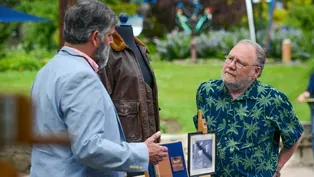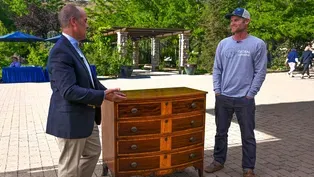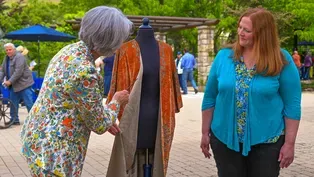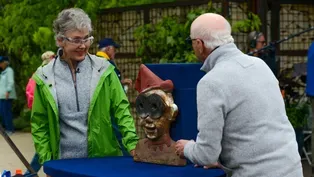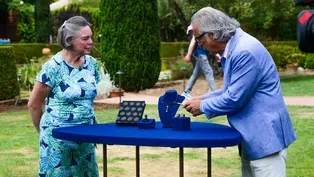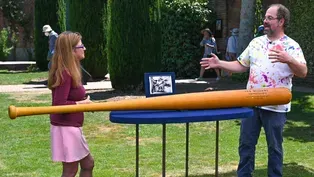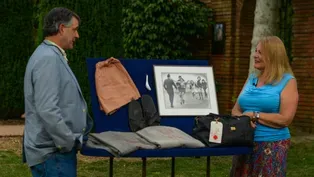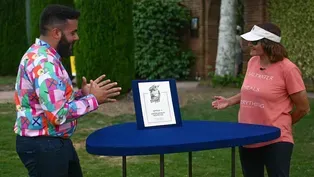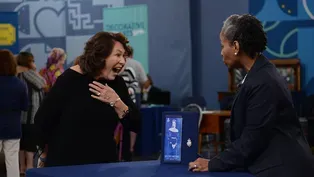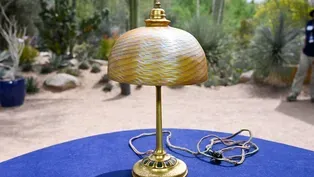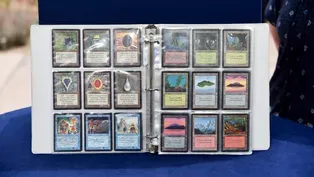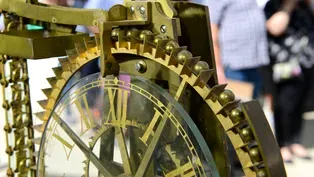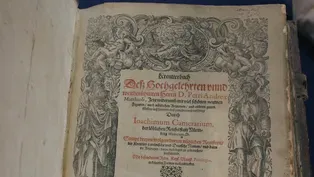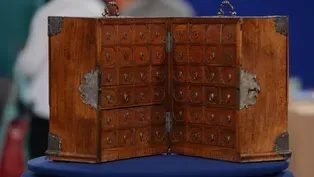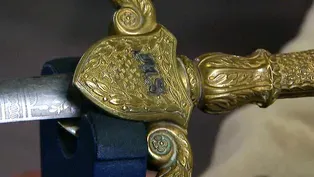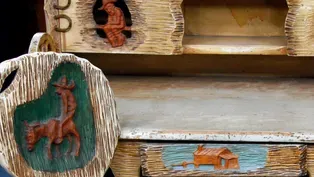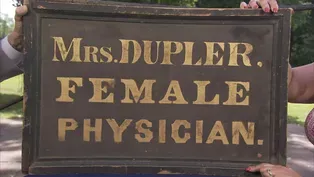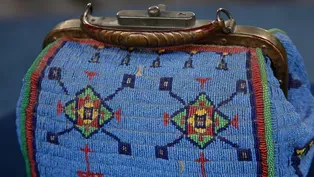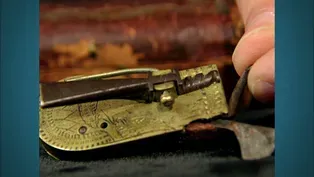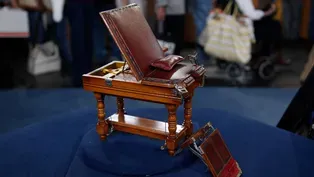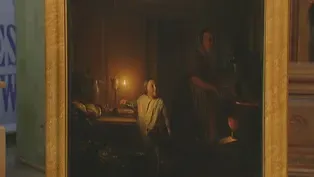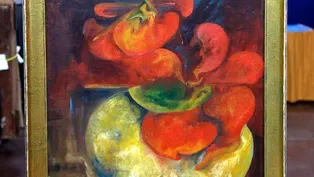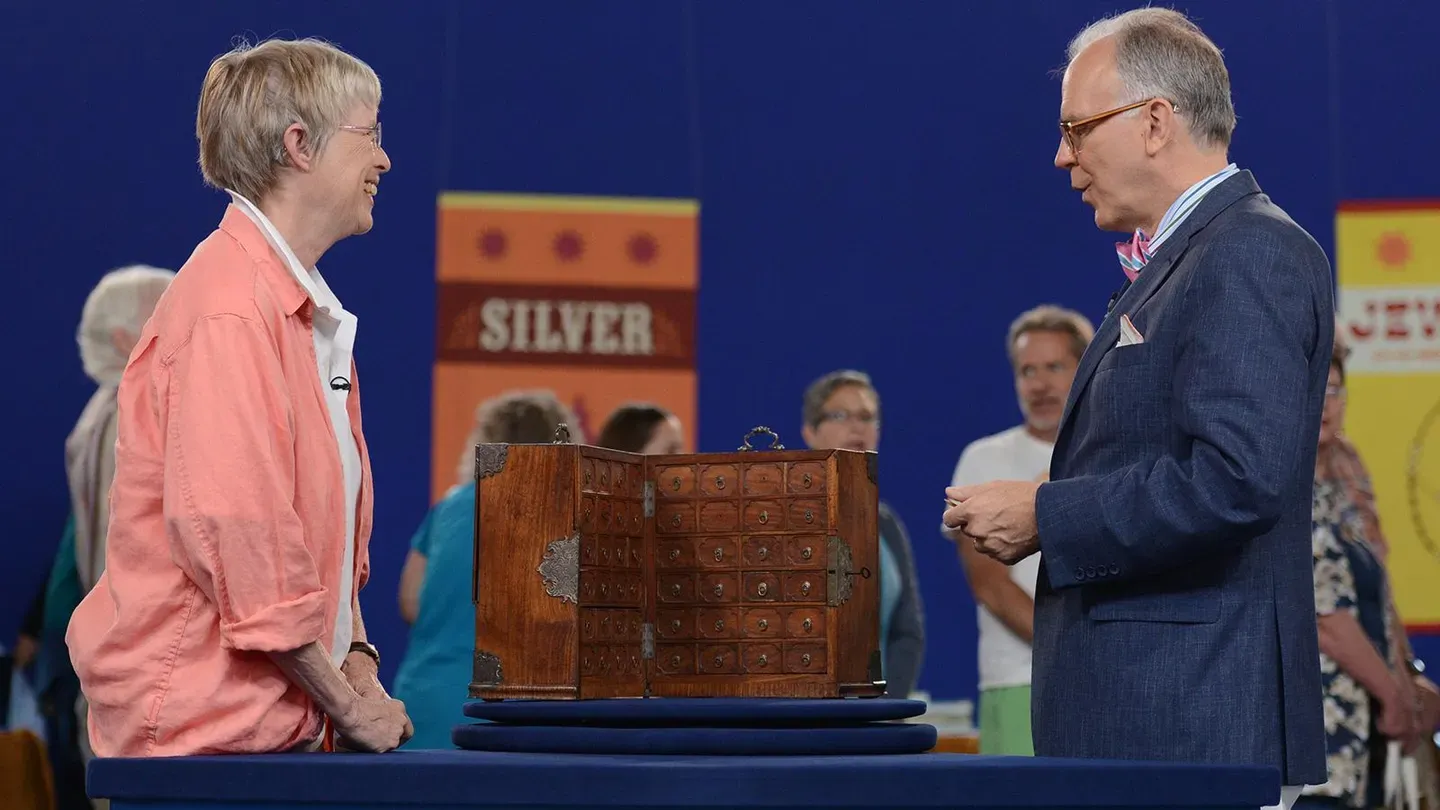

RECUT: Treasure Fever, Part 1
Special | 21m 58sVideo has Closed Captions
Explore artifacts and artistry with health and medicine history in this half-hour RECUT.
Explore artifacts and artistry with health and medicine history across generations including a Lakota Sioux doctor's bag, a “Female Physician” trade sign from around 1835, and a salesman's sample operating chair in this half-hour RECUT.
Funding for ANTIQUES ROADSHOW is provided by Ancestry and American Cruise Lines. Additional funding is provided by public television viewers.

RECUT: Treasure Fever, Part 1
Special | 21m 58sVideo has Closed Captions
Explore artifacts and artistry with health and medicine history across generations including a Lakota Sioux doctor's bag, a “Female Physician” trade sign from around 1835, and a salesman's sample operating chair in this half-hour RECUT.
How to Watch Antiques Roadshow
Antiques Roadshow is available to stream on pbs.org and the free PBS App, available on iPhone, Apple TV, Android TV, Android smartphones, Amazon Fire TV, Amazon Fire Tablet, Roku, Samsung Smart TV, and Vizio.
Buy Now
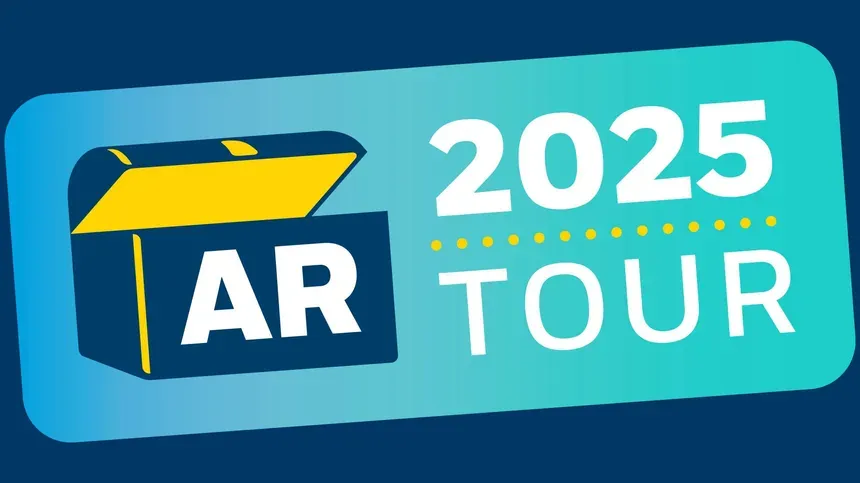
ANTIQUES ROADSHOW 2025 Tour!
Enter now for a chance to win free tickets to ANTIQUES ROADSHOW's 2025 Tour! Plus, see which cities we're headed to!Providing Support for PBS.org
Learn Moreabout PBS online sponsorshipMore from This Collection
RECUT: Idaho Botanical Garden, Part 4
Video has Closed Captions
Wrap up Season 4 of RECUT with a $50,000 appraisal at Idaho Botanical Garden! (22m 31s)
RECUT: Idaho Botanical Garden, Part 3
Video has Closed Captions
Visit the “City of Trees” for unbe-leaf-able Boise treasures in this half-hour RECUT. (22m 31s)
RECUT: Idaho Botanical Garden, Part 2
Video has Closed Captions
In this half-hour RECUT, watch breathtaking Boise appraisals at Idaho Botanical Garden. (22m 31s)
RECUT: Idaho Botanical Garden, Part 1
Video has Closed Captions
Gem State treasures sparkle in this half-hour RECUT at Idaho Botanical Garden! (22m 31s)
Video has Closed Captions
Watch wow-worthy Woodside finds in this half-hour RECUT and learn which is up to $44,000! (22m 24s)
Video has Closed Captions
In this half-hour RECUT episode, golden state treasures shine at Filoli. One is $150,000! (22m 23s)
Video has Closed Captions
Watch fascinating Filoli finds in this half-hour RECUT, including one up to $100,000! (22m 36s)
Video has Closed Captions
This season's first half-hour of RECUT wows our guests with a $200,000 to $330,000 find! (22m 30s)
RECUT: American Stories, Part 1
Video has Closed Captions
Learn the stories of objects that represent American traditions and triumphs! (22m 28s)
RECUT: Desert Botanical Garden, Part 2
Video has Closed Captions
Phoenix treasures heat up, like one appraisal up to $35,000, in this half-hour RECUT! (22m 28s)
RECUT: Desert Botanical Garden, Part 1
Video has Closed Captions
Phenomenal Phoenix finds abound in this half-hour RECUT. One is worth up to $100,000! (22m 26s)
RECUT: Crocker Art Museum, Part 2
Video has Closed Captions
See stunning Sacramento finds like one $80,000-$125,000 treasure, in this half-hour RECUT! (22m 28s)
Providing Support for PBS.org
Learn Moreabout PBS online sponsorship♪ ♪ CORAL PEÑA: "Antiques Roadshow Recut" has just what the doctor ordered.
APPRAISER: It's ghastly.
(laughing): It is.
But your grandfather was a doctor, so it's appropriate.
He was, yeah, he's a physician.
And I got chills when you told me what you had in that box.
PEÑA: It's "Antiques Roadshow Recut: Treasure Fever."
♪ ♪ So we have a whole drawer there, and even this drawer-- my goodness, look at all that.
PEÑA: "Antiques Roadshow Recut" wants to know, how are you feeling about exploring treasures related to physical and mental health and well-being?
The salesman could carry this around from town to town and show the doctor exactly what he had.
PEÑA: Illness, aches, and pains are part of life, but the stuff connected to healing the human body can bring a lot of pleasure and pride, from medical quackery... APPRAISER: Back then, electricity all of a sudden became the magic cure for everything.
PEÑA: ...to conventional health equipment... APPRAISER: It's really like a snapshot of what a doctor would have in the field back in the 19th century.
PEÑA: ...to items that are part of the history of medicine.
APPRAISER: All of these, as it's called, a Kreuterbuch, were for herbalist purposes-- remedies, nutrition, that sort of thing.
PEÑA: We've got a healthy collection of wellness-related stuff to show you.
Take a look.
MAN: We live in the Black Hills in South Dakota.
My parents ran a private museum in a Wild West show, and my dad was born in Deadwood, South Dakota.
Apparently some Lakota Native American ancestry on his mother's side.
A lot of the Native people would bring him pieces that they wanted preserved, that they were afraid would be lost in their family.
Best of my knowledge, that's where this came from.
APPRAISER: This is a Lakota bag, and it is a doctor's bag.
And as you can see, it's beaded on all sides.
Yeah.
What's a bit unusual is, a lot of the bags are white background, and this is a blue background.
It has a trade cloth lining on the inside.
There are a couple of ways that we can date this.
Yeah.
If you look right here in the center, these are metal-cut beads.
Now, metal-cut beads really date into the 1890s.
Ah.
So this bag is 1885, 1890.
Really?
And it's not thread, it's sinew.
Again, that's one of the ways that we date Native American material.
I see.
One other thing that is an issue of condition.
Do you see this area here?
Yeah, I think there's another little small spot near the bottom, a couple of beads.
Exactly.
You have a few areas that, that need to be repaired.
Now, that does impact on value.
Uh-huh.
A lot of collectors would look at this and, because it has this blue background, and because it's basically in great shape... Yeah.
It would be highly desirable for them.
And you have almost this transition from Native American into the early settlers in the West.
Yeah.
And you have the blending of those two cultures... Yeah, it's fascinating.
Right in this bag.
Juxtaposition.
I want to give you a realistic value.
And I think you can use this for insurance.
In a gallery, you would expect to see this sell for between $5,000 and $7,000.
I'm...
I'm flabbergasted.
For a thing that was just commonplace to me growing up, it was just a family item, that, that's quite a shock.
MAN: I brought to you a painting by Zelda Fitzgerald.
She painted this while she was a patient in Johns Hopkins Hospital in the 1930s.
She painted this for a doctor who was the psychiatrist in charge of the John Hopkins Hospital.
I inherited it from the doctor.
Everyone knows the story of Zelda, the beautiful young Southern belle who married F. Scott Fitzgerald, the rising artist, in 1920, and they became the quintessential sort of golden couple of the Jazz Age, of the '20s.
And they knew everyone who was everyone in Europe.
Zelda encountered many of the Modernist painters and was influenced by them, and their storybook life began to come to a rather bad end when Zelda eventually succumbed to mental illness.
She was in various mental institutions during the course of the '30s and the '40s, first in Europe and then in America.
She died tragically in a fire in 1948 in a mental institution, and part of her therapy was painting.
She became a very accomplished painter.
We're looking at oil on canvas in what is probably a frame from around that period, and it appears to be in reasonably good condition.
The rarity of these pictures does raise the question of authenticity.
I don't have an authenticity question about this picture because you brought us some very compelling documentary evidence supporting the provenance.
And this rather wonderful painting of nasturtiums also is convincing in its own right as her work.
But it would require consultation with some Fitzgerald scholars and experts in order to absolutely confirm the authenticity without any question.
The one picture which I have tracked down, from 15 years ago, sold for $4,000 at an auction in New York City.
In today's market, a conservative auction estimate on this painting would be between $10,000 and $15,000.
To insure it, you should be thinking about perhaps $20,000.
Well, that's... very nice, thank you.
Well, thank you.
I'm very excited.
I got chills when you told me what you, what you had in that box.
It's a piece of quack medicine from the 1920s.
Back then, electricity all of a sudden became the magic cure for everything.
And this is an elaborate kit.
A kit in this complete shape would sell in the $400 to $500 range.
Oh, really!
Fantastic!
It's not an original Norman Rockwell.
Okay, okay.
It's a photographic reproduction of one of his famous paintings.
Oh, okay.
If we could get the magnifying glass right onto the print, you'd be able to see... Uh-huh.
...the little photographic pixels.
Okay.
But as a reproduction, it's probably worth about $40.
Okay, okay.
$60, in that range.
But a really, really sweet image.
Okay, I like it.
(chuckling): I can see why.
(laughs) What you have here actually is a mix of things.
This is from the First World War.
This is a, an officer's medical syringe kit.
The rest of this is medicine and cures and treatment and that sort of thing that you would have during the Civil War.
Value-wise, for the lot, you'd be looking at, retail, around $350 to $400.
Okay, very good.
WOMAN: Well, my husband's great-grandfather was a pioneer physician, and I live in the house that he built in 1853, and his implements and things that he used in his pioneer physician days are in my possession now.
He made the rounds with these saddlebags and delivered babies.
This is an OB kit, which frightens me.
I always said I wanna hold my legs together when I see that.
So he did a little bit of everything.
Oh yes, oh, he just, yeah.
Country doctor had to know just about everything.
Absolutely.
And so he also did some dental work, too?
Yes, he did.
He pulled teeth, and I don't know why, but he kept the teeth.
I keep them in my kitchen.
I think it's an appropriate place to keep them.
Absolutely, where else would you put them?
(laughing): That's right.
It's really like a snapshot of what a doctor would have in the field back in the 19th century.
What we see here is that, with the wooden handle, that's before we understood bacteria.
Yes.
And so that was later replaced, it became all stainless steel.
So we see that that's probably circa 1850s, 1860s.
And then the saddlebag, which would have some medicines in it that he would carry around, again, right around that kind of mid-19th-century timeframe.
And the picture shows the Dr. Arnold, and then who are the other folks in the picture?
They're the two other Dr. Arnolds.
So it's a family of doctors.
It's a, three, three generations there.
To the right collector, retail value, adding everything up, I think we have at least $1,000 worth of items here, so... Really.
It's been in my family for only about 30 years.
It was given to my grandmother by a gentleman who apparently had an uncle who was a doctor.
Mm-hmm.
And he was going to throw out all the tins and use the box as storage.
This is a student's cabinet made by the Parke-Davis Company.
Mm-hmm.
Who's still in business today.
Probably made around the turn of the century: 1890, 1900.
And it is, going by the list here, little sample tins of various medical roots, medical herbs, and all kinds of natural remedies.
And then there are more in the drawers, correct?
Yep.
So we have a whole drawer there.
And then, this drawer's full, and even this drawer... My goodness, look at all that.
And they...
They get bigger as they go down.
And it's a graduated set.
The fact that it's survived is amazing.
I've seen these tins from time to time at flea markets, in boxes, in medical bags, and they're worth, on their own, five dollars, ten dollars, $20 each.
I've never seen-- how many of them?
288.
All in very good condition, with a few exceptions.
And they're mostly full, aren't they?
Except for three.
Except for three.
And what ones are missing, do you remember?
I don't know of the other two, but I know that one was cannabis sativa, which my older brother got to.
Your brother got to the cannabis.
We won't go there.
(chuckles) Because it's complete, excellent condition, I would give a rough guesstimate of $5,000 to $7,000 for the whole kit and caboodle.
Cool.
Great thing to find in the trash.
Yes.
WOMAN: It is a book from my father's family.
It has been in the family, I believe, since his grandfather.
We believe it's dated 1586... APPRAISER: Well, it certainly is, it's right here on the cover.
His grandfather was a pharmacist.
And it was brought with a group of books from Europe?
Yes.
When was that?
We brought them over only about two or three years ago.
Right.
But they have been in the family for a very long time.
It's notable, particularly because of its binding, with the date of publication squarely stamped on the blind-tooled pigskin cover, which is over... (knocks): Solid wooden boards.
Unfortunately, the front board has split.
And the book is a very popular text.
It's by Mattioli, who was born in Siena in 1501 and died in 1577.
Oh.
Okay.
And he was a herbalist.
His text was widely published, first of all, in Italy.
This is a German edition edited by a Nuremberg physician called Joachim Camerarius.
You see here, Nuremberg medicine, published in Frankfurt am Main... Mm-hmm.
In 1586.
The beauty of this book is that it's among the earliest series of botanical illustrations using a woodcut technique.
Oh, okay.
But making the illustrations from life specimens.
Okay.
From the plants themselves.
All of these, as it's called, a Kreuterbuch... Mm-hmm.
...were for herbalist purposes: remedies, nutrition, that sort of thing.
Is it done on the Gutenberg press?
This is nearly 150 years post-Gutenberg.
Okay.
This is a perfectly respectable printing outfit in Frankfurt.
Back here, we'll see the printer's mark.
Okay.
It's Frankfurt am Main, and it's printed by Sigmund Feyerabend.
Okay.
And there's the printer's device.
And there's the date of the printing.
And it's seen some wear: it's got some wormholes, it lacks its tabs and clasps.
But it's the most beautiful, nice, original old object.
Mattioli's works have been bringing quite a lot of money recently.
I would value this at $25,000 for insurance purposes.
(gasps): Wow.
Wow!
That's great.
(laughs) WOMAN: This piece was my grandfather's.
It's ghastly.
(laughing): It is.
But your grandfather was a doctor, so...
He was, yeah-- he's a physician, so...
It's appropriate.
Andy Anderson is a self-taught carver.
He was born in 1893, started carving in earnest in the late '20s, and got a job at Knott's Berry Farm in the early '30s.
He had a booth there, and he would carve all day long and make these, essentially, tourist gifts for, for visitors at Knott's Berry Farm.
Oh, okay.
APPRAISER: This is a "White's Physiological Manikin."
There are fold-out parts to this, so that you can show the patient or the medical student different veins in the body.
You can look at where the bones run through the leg.
It goes into the muscles and the tendons and the ligaments.
This is very detailed and wonderful work.
I would say that this one is worth somewhere in the vicinity of $1,000 to maybe as much as $1,500.
Very interesting piece.
Wow, I...
I'm just shocked.
(laughs) I'm shocked.
WOMAN: This is a sign that was found in my home in Urbana, Ohio, back in, like, 1970s, when I was a kid.
And it was behind an upstairs wall, like, a knee wall space.
There was a Dr. Jacob Leonard that lived in my home in the 1800s.
And he had a daughter by the name of Sarah, and she married a John Dupler.
And she might have been a doctor.
That's all I can tell.
This is a very, very rare American trade sign.
It's made of one piece of wood with a beautiful deep dish surround molding.
The lettering is gilt, and all around the sign is this sparkly substance.
People call these sand signs.
Okay.
But they're really smalt-- S-M-A-L-T. And smalt is crushed glass.
And they would actually glue that to the wood for these early trade signs, which made the wood almost impervious to the weather.
And that's one of the reasons this sign, this is in such wonderful condition.
The bracket is all original, early iron.
Probably dates to about 1830, 1840.
And a woman physician?
Pretty rare.
The sign would have hung perpendicular to the street.
And on the other side of the sign, it says "Mrs. S. Dupler," and it uses the word "doctress."
And a doctress is a female physician.
However, in the early 19th century, the term doctress was also applied to someone that had magical healing powers.
Ooh.
We're gonna put an insurance value on the sign of $2,500 to $3,500.
Okay.
WOMAN: It was bequeathed to me by a friend.
I believe it's a tansu, based on the design.
But what I love about this chest is all its secret compartments.
And I design and build contemporary furniture and contemporary tansu, and I build secret compartments into everything that I build.
The card that came with it said it was a 1740s Queen Anne apothecary chest, purported to be used for nobility.
One can pull out one of these and see that you've got this terrific little box, but it's really a visual pun.
Yes.
Because most of these are not, in fact, drawers; they are other things.
They are other things.
They're sliding doors, or they are drawers designed to look like four small drawers, but in fact, they're broken up into compartments that have all kinds of other things going on.
Right.
And that's because this was made for someone who was a pharmacist.
It actually hinges together and forms a box, and you've got this wonderful plate here on the front, and the corners are reinforced with these metal plates.
These are in a Baroque, kind of Rococo design, which is a European design.
We're going to just look at the whole exterior, and what do we see?
The side that looks like it's one solid panel in fact slides open.
You had said tansu, which is a type of furniture used in Japan and Korea.
This actually is made of a wood that is not teak, not padauk.
It's a wood called huanghuali.
Huanghuali was a wood that was used in Chinese cabinetry work.
Oh, okay.
From an early period of time during the Ming dynasty and the Qing dynasty up into the 18th century.
It wasn't really used by any other cultures in Asia.
Okay.
That and this hinged box form is a Chinese form.
This was made by a Chinese cabinetmaker probably between 1720 and 1750.
This was made for somebody who was a well-to-do individual.
This was likely made in Southern China, probably in what was then called Canton.
And it was made for someone who was working there or brought it back from there to Europe.
And stylistically, I think that individual is likely Dutch.
Really?
And I base that on the style of these mounts.
What a terrific object.
Wow, thank you.
This is so, so fun.
And the fact that it's miniaturized really makes it appealing, because it's portable and small.
Right.
It's worth, I think, conservatively, $8,000 to $12,000 at auction.
Oh, wow.
Wow.
(chuckles) That's amazing.
(voice breaking): I can't believe, such a gift!
If they were Chinese mounts, not these European mounts, this would be worth $50,000 to $70,000 at auction.
Oh, wow.
MAN: Well, it belonged to my great-grandfather.
He was a doctor.
I know it was a salesman sample that he kept in his office.
When my parents passed away, I inherited it.
My mother sent pictures of it to an appraiser in San Francisco in, I believe, '79 or '80, and they sent her back a note saying it was worth around $1,500.
Well, it is a salesman sample.
The keynote of a really good salesman sample is that it has functionality.
Because the whole object of the piece was to demonstrate the item.
The salesman could carry this around from town to town and show the doctor exactly what he had.
And of all the salesman samples I've dealt with over the years, this is probably the most amazingly functional item I've ever seen.
It's a doctor's examination table.
The patient could lie down here and be examined with a pillow.
If he had to have his height adjusted, this could be adjusted here.
The legs would come up like this.
They could even... ...do one leg at a time.
Hold them together.
This is a little accessory that would go on the side if he had to examine an arm, or maybe... That's what I thought, for the arm.
...draw blood.
And it could, of course, go on either side.
The table would rock to one side.
I'm not exactly sure what that was for, but it could go either way.
This whole leg assembly comes off.
Oh, I didn't know that.
So that another feature of the table could be in place, where it becomes a gynecological examination table with the installation of these stirrups.
Another thing that elevates this salesman sample to the next level is if we can identify the maker.
Now, right here, on this upholstered foot rest, we see "Allison."
There was a company called W.D.
Allison in 1905, 1900, in Indianapolis that made all manner of medical equipment.
Uh-huh.
Nothing they made in that period that I've seen online was as amazing as this table.
But I think this table was made pre-1900.
Amazing detail.
Amazing condition.
Complete in all respects.
Uh-huh.
I would estimate it in an auction at $15,000 to $18,000.
You're kidding.
I am not kidding.
Wow.
This is absolutely one of the finest salesman samples I have ever seen.
♪ ♪ PEÑA: Thanks for watching.
We hope you enjoyed this episode of "Antiques Roadshow Recut."
Appraisal: 1586 Mattioli German Ed. "Herbal" Book
Video has Closed Captions
Appraisal: 1586 Mattioli German Ed. "Herbal" Book (2m 58s)
Appraisal: Chinese Export Huanghuali Cabinet, ca. 1735
Video has Closed Captions
Appraisal: Chinese Export Huanghuali Cabinet, ca. 1735 (3m 17s)
Appraisal: Civil War Model 1840 Medical Officer's Sword
Video has Closed Captions
Appraisal: Civil War Model 1840 Medical Officer's Sword (39s)
Appraisal: Dr. Niblack Carved Desk & Chair, ca. 1950
Video has Closed Captions
Dr. Niblack Carved Desk & Chair, ca. 1950 (1m 7s)
Appraisal: Female Physician Trade Sign, ca. 1835
Video has Closed Captions
Appraisal: Female Physician Trade Sign, ca. 1835 (1m 49s)
Appraisal: Lakota Sioux Doctor's Bag, ca. 1895
Video has Closed Captions
Appraisal: Lakota Sioux Doctor's Bag, ca. 1895 (2m 16s)
Appraisal: Physician's Grouping, ca. 1850
Video has Closed Captions
Appraisal: Physician's Grouping, ca. 1850 (1m 36s)
Appraisal: Salesman's Sample Medical Exam Table, ca. 1890
Video has Closed Captions
Appraisal: Salesman's Sample Medical Examination Table, ca. 1890 (2m 44s)
Appraisal: Student Medicine Cabinet, ca. 1900
Video has Closed Captions
Appraisal: Student Medicine Cabinet, ca. 1900 (1m 45s)
Appraisal: Zelda Fitzgerald Oil Painting, ca. 1935
Video has Closed Captions
Appraisal: Zelda Fitzgerald Oil Painting, ca. 1935 (2m 41s)
Providing Support for PBS.org
Learn Moreabout PBS online sponsorshipFunding for ANTIQUES ROADSHOW is provided by Ancestry and American Cruise Lines. Additional funding is provided by public television viewers.


